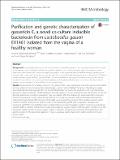Files in this item
Purification and genetic characterization of gassericin E, a novel co-culture inducible bacteriocin from Lactobacillus gasseri EV1461 isolated from the vagina of a healthy woman
Item metadata
| dc.contributor.author | Maldonado-Barragan, Antonio | |
| dc.contributor.author | Caballero-Guerrero, Belen | |
| dc.contributor.author | Martin, Virginia | |
| dc.contributor.author | Luis Ruiz-Barba, Jose | |
| dc.contributor.author | Miguel Rodriguez, Juan | |
| dc.date.accessioned | 2021-07-15T11:30:07Z | |
| dc.date.available | 2021-07-15T11:30:07Z | |
| dc.date.issued | 2016-03-12 | |
| dc.identifier | 274694423 | |
| dc.identifier | 7b147aa8-ba5f-465d-9531-86569b41521c | |
| dc.identifier | 000372311800001 | |
| dc.identifier | 84960491521 | |
| dc.identifier.citation | Maldonado-Barragan , A , Caballero-Guerrero , B , Martin , V , Luis Ruiz-Barba , J & Miguel Rodriguez , J 2016 , ' Purification and genetic characterization of gassericin E, a novel co-culture inducible bacteriocin from Lactobacillus gasseri EV1461 isolated from the vagina of a healthy woman ' , BMC Microbiology , vol. 16 , 37 . https://doi.org/10.1186/s12866-016-0663-1 | en |
| dc.identifier.issn | 1471-2180 | |
| dc.identifier.other | ORCID: /0000-0002-4775-346X/work/95772962 | |
| dc.identifier.uri | https://hdl.handle.net/10023/23578 | |
| dc.description | This work was supported by the Spanish Ministry of Economy and Competitiveness (MINECO) through the Project AGL2012-33400 and AGL2013-41980-P, and by the Junta de Andalucía Excellence Project AGR-07345. These projects included FEDER funds. AMB was the recipient of a post-doctoral grant awarded by the Junta de Andalucía as part of the Project AGR-07345. | en |
| dc.description.abstract | Background: Lactobacillus gasseri is one of the dominant Lactobacillus species in the vaginal ecosystem. Some strains of this species have a high potential for being used as probiotics in order to maintain vaginal homeostasis, since they may confer colonization resistance against pathogens in the vagina by direct inhibition through production of antimicrobial compounds, as bacteriocins. In this work we have studied bacteriocin production of gassericin E (GasE), a novel bacteriocin produced by L. gasseri EV1461, a strain isolated from the vagina of a healthy woman, and whose production was shown to be promoted by the presence of certain specific bacteria in co-culture. Biochemical and genetic characterization of this novel bacteriocin are addressed. Results: We found that the inhibitory spectrum of L. gasseri EV1461 was broad, being directed to species both related and non-related to the producing strain. Interestingly, L. gasseri EV1461 inhibited the grown of pathogens usually associated with bacterial vaginosis (BV). The antimicrobial activity was due to the production of a novel bacteriocin, gassericin E (GasE). Production of this bacteriocin in broth medium only was achieved at high cell densities. At low cell densities, bacteriocin production ceased and only was restored after the addition of a supernatant from a previous bacteriocin-producing EV1461 culture (autoinduction), or through co-cultivation with several other Gram-positive strains (inducing bacteria). DNA sequence of the GasE locus revealed the presence of two putative operons which could be involved in biosynthesis and immunity of this bacteriocin (gaeAXI), and in regulation, transport and processing (gaePKRTC). The gaePKR encodes a putative three-component regulatory system, involving an autoinducer peptide (GaeP), a histidine protein kinase (GaeK) and a response regulator (GaeR), while the gaeTC encodes for an ABC transporter (GaeT) and their accessory protein (GaeC), involved in transport and processing of the bacteriocin. The gaeAXI, encodes for the bacteriocin gassericin E (GasE), a putative peptide bacteriocin (GaeX), and their immunity protein (GaeI). Conclusions: The origin of the strain (vagina of healthy woman) and its ability to produce bacteriocins with inhibitory activity against vaginal pathogens may be an advantage for using L. gasseri EV1461 as a probiotic strain to fight and/or prevent bacterial infections as bacterial vaginosis (BV), since it could be better adapted to live and compete into the vaginal environment. | |
| dc.format.extent | 13 | |
| dc.format.extent | 1261272 | |
| dc.language.iso | eng | |
| dc.relation.ispartof | BMC Microbiology | en |
| dc.subject | Bacteriocin | en |
| dc.subject | Quorum sensing | en |
| dc.subject | Gassericin | en |
| dc.subject | Three-component regulatory system | en |
| dc.subject | QH426 Genetics | en |
| dc.subject | QR Microbiology | en |
| dc.subject.lcc | QH426 | en |
| dc.subject.lcc | QR | en |
| dc.title | Purification and genetic characterization of gassericin E, a novel co-culture inducible bacteriocin from Lactobacillus gasseri EV1461 isolated from the vagina of a healthy woman | en |
| dc.type | Journal article | en |
| dc.contributor.institution | University of St Andrews. School of Medicine | en |
| dc.identifier.doi | https://doi.org/10.1186/s12866-016-0663-1 | |
| dc.description.status | Peer reviewed | en |
This item appears in the following Collection(s)
Items in the St Andrews Research Repository are protected by copyright, with all rights reserved, unless otherwise indicated.

